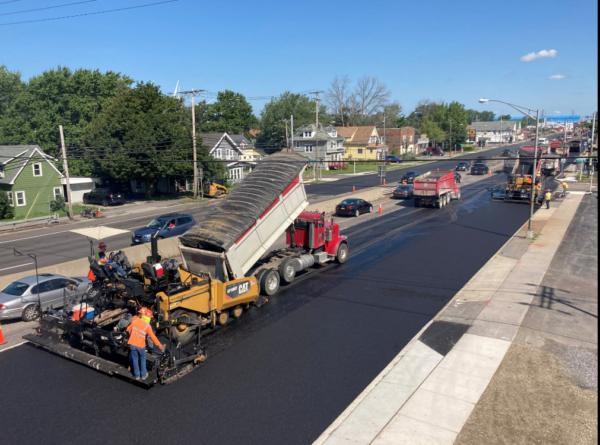A high percentage of roads and bridges in the Hudson Valley are in either poor or mediocre condition, according to a new report by TRIP, a Washington, D.C. nonprofit that does research on highway and transit issues.
Drivers in the Poughkeepsie-Newburgh-Middletown area are shelling out an average of $1,839 each in higher vehicle operating costs due to wear-and-tear and damage from poor surface conditions, costs of accidents and costs of delays due to congestion, TRIP found.
A January 2022 report by TRIP found that nearly half of the important roads in New York state that are maintained locally or by the state itself are in poor or mediocre condition.

The TRIP report found that 18% of major locally- and state-maintained roads in the Poughkeepsie-Newburgh-Middletown urban area are in poor condition and another 38% are in mediocre condition. Those Hudson Valley numbers differ somewhat from statewide data showing 26% of the state”™s major roads are in poor condition and 19% are in mediocre condition.
In the Poughkeepsie-Newburgh-Middletown urban area, 15% of bridges are rated poor or structurally deficient, while statewide 10% of the road bridges fall into those categories. A poor or structurally deficient rating means there has been significant deterioration to the bridge deck, supports or other major components.
John Ravitz, executive vice president and COO of the Business Council of Westchester, during a news conference arranged by TRIP, said, “As we look to encourage businesses to come to Westchester County and the Hudson Valley, as we look to retain businesses and help them grow in Westchester County and the Hudson Valley, we need to be able to show them that ”¦ bridges and tunnels and overpasses in the county are being improved, are safe and that we don”™t have a reliability issue that really puts peoples”™ lives at risk.”
Ravitz said that when he was a member of the state Assembly, it was known that road and bridge repairs needed to be made but there were questions of whether the funding was available to do what was needed.
“We know that the funding now is there,” Ravitz said referring to federal infrastructure money. “We need to use that funding strategically to make the improvements in our transportation infrastructure so that we can send that clear message to the business community in Westchester and around the country so that if you do come here to open up shop you are going to have safe roads, safe bridges, safe underpasses for your employees and also for your customers.”
John Cooney Jr., executive director of the Construction Industry Council of Westchester and the Hudson Valley, said, “For the year ended in 2020 in the Hudson Valley, 58.5% of the roads were rated poor and fair condition, the highest percentage in the state. In addition, 45.9% of the region”™s bridges were rated poor and fair condition, also the highest in the state.”
Cooney said that investment in roads and bridges represents an investment in the state”™s general economy.
“Over $1 trillion in goods are shipped to sites within New York,” Cooney noted. “Further, the American Road and Transportation Builders Association reports that there are 319,000 full-time jobs involved with the design, construction and maintenance of New York”™s transportation infrastructure.”
TRIP reported that transportation construction in New York annually contributes an estimated $1.8 billion in state and local income, corporate and unemployment insurance taxes and federal payroll taxes. It pointed out that approximately 3.5 million full-time jobs in New York in key industries such as tourism, retail sales, agriculture and manufacturing are dependent on the quality, safety and reliability of the state”™s transportation infrastructure network. TRIP cited statistics showing that workers in those industries earn $145 billion in wages and contribute an estimated $26.4 billion in state and local income, corporate and unemployment insurance taxes and federal payroll taxes.
Cooney expressed optimism that Gov. Kathy Hochul and other state officials will push to make sure that infrastructure funds provided by the federal government actually will be spent on doing the repairs and improvements that are needed in the Hudson Valley and across the entire state.
“These latest findings by TRIP shed more light on the continued need to address the countless roads and bridges, causing businesses and employees time and money,” said Melvin Norris, senior director of government affairs for The Business Council of New York State, Inc. “These careful studies can be used as a roadmap to finally address and solve these problems altogether. We are hopeful that the federal infrastructure package will help in solving this ongoing problem.”
TRIP reported that the annual spending on roads, highways and bridges by the New York State Department of Transportation (NYSDOT) increased by 37% from 2018 to 2021 from approximately $4.3 billion to $6 billion.
“The level of NYSDOT highway investment is likely to increase further as a result of the five-year federal Infrastructure Investment and Jobs Act signed into law in November 2021, which will increase annual federal funding for New York roads, highways and bridges by 52% from an average of approximately $1.8 billion in federal money annually to $2.7 billion,” TRIP reported.





















